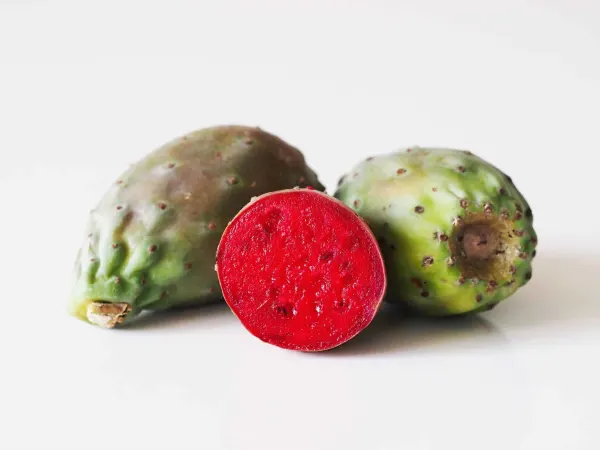Access our First Foods® Database in the Solid Starts App.
Learn morePrickly Pear (Cactus Fruit)
Fruit
Age Suggestion
6 months
Iron-Rich
No
Common Allergen
No

When can babies eat prickly pear?
Prickly pear (cactus fruit), if strained and its seeds removed, may be introduced as soon as baby is ready to start solids, which is generally around 6 months of age. Wait to serve prickly pear juice or prickly pear candy until at least 12 months of age and ideally after the second birthday. Looking for the cactus paddles? See nopales.
How do you prepare prickly pear for babies with baby-led weaning?
Every baby develops on their own timeline, and the suggestions on how to cut or prepare particular foods are generalizations for a broad audience.
6 to 24 months old:
For babies and toddlers who are still learning how to eat, it is best to mash the fruit and strain the juicy flesh from the seeds, which can be aspirated into the lungs. Wash and scrub the fruit with a brush under water, then peel the skin, mash the fruit, and discard the seeds. From there, use the juice as a sweet-tart marinade for cooked vegetables like carrot, chayote, jicama, nopales, or proteins like chicken, pork, salmon, or tofu. You can also stir some of the juice into mashed vegetables, porridge, or shredded meat. Or try drizzling some juice on top of pancakes, or serve alongside meatballs, bean patties, or cooked fruit or vegetable spears as a dip. Refrain from offering the juice on its own as a drink or processed prickly pear products like jam, jelly, paste, or syrup, which are too sugary for babies.
24 months old and up:
Time for the next step! When you feel confident in the child’s eating skills and the child understands instructions, try offering a whole peeled prickly pear and model how to bite into the juicy flesh and spit out the seeds by eating a fruit alongside the child. Be sure to stay within an arm’s reach in case help is needed. If you feel the child is not ready for fruit with seeds, continue to offer foods flavored with prickly pear that has been mashed and deseeded. At this age, you can also experiment with prickly pear by serving dishes that you can enjoy alongside the child, such as prickly pear salsa, prickly pear salad, or smoothies with prickly pear juice.
Cutting a peeled prickly pear to show you the seeds inside. Offering discs like this with the seeds inside may not be age appropriate until closer to age 2 or 3 when the child understands instructions.
Learn about how you can help children form a healthy relationship with sugar on our Sugar & Taste Preferences page.
Videos
Is prickly pear a common choking hazard for babies?
Yes. Prickly pear flesh is slippery and can be firm, two qualities that can increase the risk. Prickly pear fruit also contains copious amounts of hard, though edible seeds which could be aspirated into the lungs. To reduce the risk, peel and mash the fruit, then strain out the seeds, which are edible but too firm, small, and difficult for babies to spit out, which can pose an aspiration risk. As always, make sure to create a safe eating environment and stay within arm’s reach of baby at mealtime.
For more information on choking, visit our sections on gagging and choking and familiarize yourself with the list of common choking hazards.
Is prickly pear a common allergen?
No. Allergies to prickly pear are rare, although allergy to cactus fruit has been reported.
Prickly pears are often prepared for sale by removing their spines, but if you find the fruit with the spines still intact, be aware that contact with the spines is commonly associated with the development of a rash. Even purchased fruit may have hair-like spines on its skin that are difficult to see. To minimize the risk, wash and scrub the fruit with a brush under water, then peel the skin before serving.
As you would when introducing any new food, start by offering a small amount of prickly pear for the first few servings. If there is no adverse reaction, gradually increase the amount served over future meals.
Is prickly pear healthy for babies?
Yes. Prickly pear contains fiber, vitamin B6, and plenty of antioxidants to support heart health and the immune system.
While the seeds of the prickly pear fruit are edible, they can be challenging to separate from the fruit flesh. For this reason, prickly pear is often commercially strained and made into juice, candy, and jellies. Avoid serving juice, candy and processed foods with added sugar to babies under 12 months of age, and ideally, closer to the second birthday. Regular consumption of sweet beverages can reduce the diversity of foods a child is interested in and increase the risk of obesity, diabetes, heart disease, and dental caries.
Where do prickly pears come from?
Prickly pear is the colorful fruit of a sprawling family of cactus that originated in the Americas. The fruit has been harvested by the Nahuan people as food and medicine for thousands of years before colonizers arrived in Central America and took the seeds to Europe, where the cactus plant now thrives in places like the sunbaked slopes of Mount Etna in Sicily. Today, prickly pear cactus thrives worldwide wherever the weather is hot and arid, and there are hundreds of varieties to try, with seedy fruits that range in color from crimson to fiery orange to sunny yellow to lime green to deep purple. The fruits taste sweet with a soft crunch like a cucumber when eaten fresh out of hand, and they are often pressed for their refreshing juice – a sweet treat called agua fresca or agua de tuna. In Spanish, prickly pear are often called tuna and the edible paddles are known as nopales, a loanword from the Nahuatl language.
Our Team
Written by
Expert Tips Delivered to Your Inbox
Sign up for weekly tips, recipes and more!
Copyright © 2025 • Solid Starts Inc









